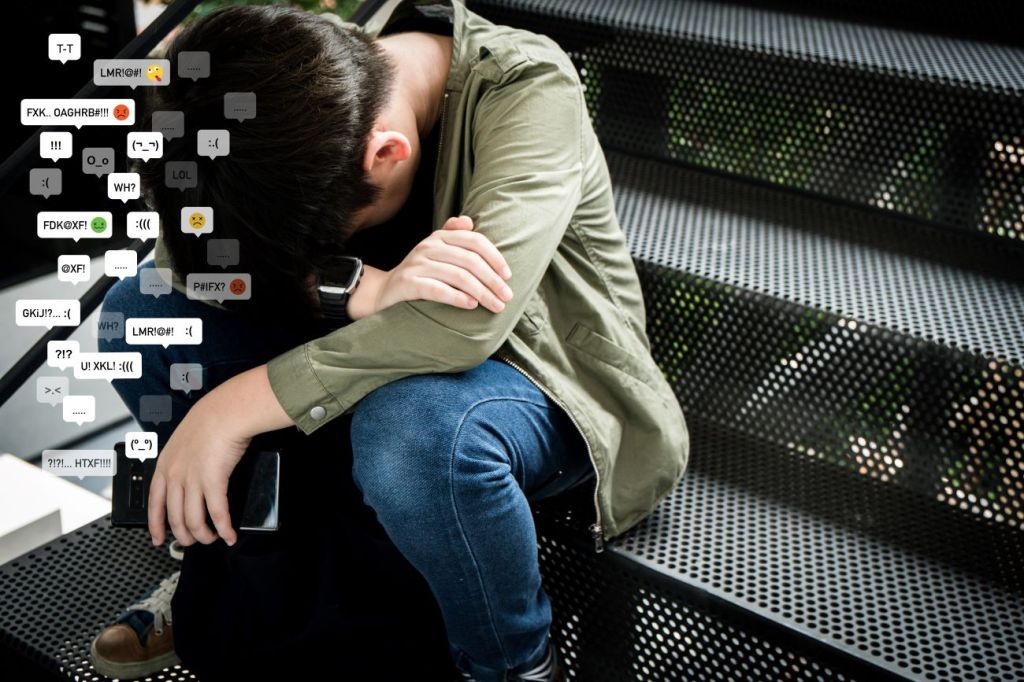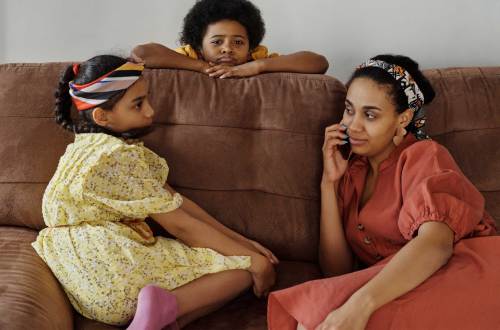Kids and teens are growing up in a world where social media is an everyday part of their lives. That’s why it’s important for parents to help them understand the good and the bad that come with the online world. While social media is great for connecting with friends and family, keeping up to date with trends, and even learning new skills, it has some downsides. One of which is cyberbullying.
Cyberbullying is one of the negative repercussions of using social media, especially amongst Gen Z. Understanding and having an open discussion about cyberbullying with your kids is highly recommended. This article will help you navigate that discussion, along with equipping you with the knowledge you may need to manage cyberbullying if the situation arises.

What is cyberbullying?
Cyberbullying is bullying that takes place in a digital space. Cyberbullying can take place through social media, text messages, online gaming, and more.
How many teens are affected by cyberbullying?
According to Broadband Search, “Sixty per cent of teenagers have experienced some sort of cyberbullying.”
What are the social effects of cyberbullying?
Cyberbullying may cause mental health issues, social anxiety, a dip in academic performance, or more aggressive behaviour. As parents, you want the best for your kids, and you do not want to see them being subjected to any form of bullying.
What are the different types of cyberbullying?
With the variety of social media platforms and the number of things that teens and tweens can upload online, there are different opportunities for people to comment on. As a result, there are different types of cyberbullying based on the content being created by users online. Here are some of the different types of cyberbullying:
Harassment
This is a broad term and can cover many aspects of cyberbullying. However, in this context, harassment can refer to a constant pattern of hurtful comments and messages and can lead to harm or mental health-related issues. Online harassment is usually when the same person or group leaves negative comments, spreads rumours, sends insulting messages, and engages in constant texting wars.
Impersonation
There are situations of cyberbullying where the bully can resort to creating profiles that are similar to their target. For example, they would create a profile of the victim and post offensive things, making it look like the victim posted those things. They could use the profile to message other people things that are inappropriate, such as insults or rude messages.
Learn more: What kids and teens need to know about online privacy.
Inappropriate photos
Some online bullies can resort to taking pictures of their victim, such as in the locker room, and threatening to share them online, or even going ahead and sharing them to shame the victim. There are also situations where some bullies may threaten to share embarrassing pictures of the victim on social media in exchange for a favour such as homework or lunch money.
Website creation
Some extreme cases of cyberbullying can lead to the bully creating a website or blog aiming to post negative things about the victim. The blog could include negative polls, sharing embarrassing stories about the person they’re attacking, and possibly embarrassing images.
Video shaming
When someone is being bullied physically, it can sometimes be recorded, and the bully may post it online. Sometimes, bullies may take videos of their target in an embarrassing situation or even set up such a situation to post online.
Trolling
This is technically not a form of cyberbullying, but it can be if the comments are hateful or rude. People who post troll comments are usually detached from their victims and may post mocking comments on anyone’s content.
Learn more: The Pros and Cons of Social Media for Kids and Teens
How does cyberbullying affect teens?
Any negative behaviour can have an impact. Teens and kids, in general, are going through a phase and figuring out who they are. Adding cyberbullying to that equation could influence their mental health and how they perceive themselves.
Some of the effects of cyberbullying on youth include:
Depression and anxiety
Constant cyberbullying can isolate a person and leave them feeling lonely. Hurtful comments online can be ignored, but if cyberbullying is constant, it can make your child wonder if some aspects of the comments are true. This can lead to negative thoughts and feeling sad while increasing a sense of worry and isolation.
Learn more: How to talk to kids and teens about mental health.
Low self-esteem
As teenagers are still growing and figuring out who they are, it can have a negative effect when a bully comments on who they are or how they look. They can question if a certain comment is true and find faults in themselves. Additionally, constant cyberbullying can also make them wonder, “why is this happening to me?” This can lead to low-self esteem and self-doubt.
Academic performance issue
Mental health is very important to all of us, including teenagers. However, being in a constantly negative headspace can distract them from other important things in life, including their academic performance.
Using substances
In extreme cases of cyberbullying, some kids can’t handle the pressure and may resort to taking drugs and or alcohol to numb their thoughts. Substance abuse can cause a domino effect and affect other areas of their lives, such as academic performance, social life, and general physical and mental health.
Anger and/or mood swings
A common sign of cyberbullying can be anger or mood swings. While this can also be a general teenage temperament, parents should always check in with their kids and teens to ensure they can handle their emotions effectively.
Behavioural changes
Different kids react differently to cyberbullying. Some kids may find it difficult to sleep or eat, and these are signs to look out for. Be aware of any anxiety that may keep them up at night or stop them from eating.

How to deal with cyberbullying
Cyberbullying could happen to anyone. It’s important for your tween and teen to know that it’s not their fault. While they may feel powerless, there are some things they can do to manage cyberbullying, if it should happen to them.
1. Don’t retaliate
People who engage in cyberbullying are usually looking to upset the person they’re targeting or get a response. While it’s hard not to scratch an itch, talk to your teen about not retaliating to the cyberbullying, which could potentially escalate the bullying. That means not writing a salty reply (or meme) in response and no name-calling.
2. Don’t reread the posts
Encourage your teen to resist the urge to reread any comments or posts, as it may lead to them ruminating about what was posted. Instead, talk to your kids about how the issue is with the person doing the bullying, not with them.
3. Report the behaviour
The person doing the bullying may delete their comment or post, so have your kids take screenshots first, so they have evidence of the cyberbullying. Then they can report offending posts or comments to the social media platform or to a moderator, in the case of something like a Facebook group.
4. Take a social media break
Encourage your teen to take a break from technology for a couple of days. Most of us use our phones for things other than social media, so have them sign out of apps or delete them completely off their phone until they’re ready to go back online.
5. Seek support
It’s understandable that your child is going to feel upset about being the target of cyberbullying—especially if it’s by someone they know. Be sure your tween or teen knows they can come to you for comfort and support. Suggest to them they also write a short list of things that make them better and do some of those. It could be taking a warm bath, snuggling up on the couch watching their favourite Netflix sitcom or spending time with a trusted friend.
How can parents prevent cyberbullying
As parents, you want the best for your kids, and you don’t want to see them being subjected to any form of bullying.
Below are some suggestions on what parents can do to help prevent cyberbullying:
Go through your child’s contact lists with them
Take the time out to go through your child’s contact lists on their phone, social media platforms, and emails. Let them tell you who each person is, how they know each other, and what kind of relationship they have. Do this regularly to ensure everything is going well.
Talk to your kids about cyberbullying
Explain the concept of cyberbullying and how your kids should talk to you if anything happens. Do this regularly as well, so that they are conditioned to know that they can come to you whenever they need to. Also, assure them that if they are cyberbullied, it’s not their fault.
Familiarize yourself with social media apps
While you know which social media apps are available, it is important to know how to navigate them as well. It would be helpful to know which social media apps are popular with teens and how to use them. You could even ask your kids to walk you through them. We’ve also put together a social media guide for parents, which helps break down the most popular social media platforms.
Check on your kids’ mental health
Even outside of cyberbullying, it’s always advisable to check on your kids’ mental health. It will help you understand what’s going on in their minds and look out for any early signs of cyberbullying—if any.
Cyberbullying is an important issue that many teens face. To ensure that your kids are using social media responsibly, talk about the safety precautions surrounding social media use and encourage your kids and teens to share any uncomfortable situations that could lead to cyberbullying.
Download Mydoh to help your kids learn, earn and save while making smart decisions.
This article offers general information only and is not intended as legal, financial or other professional advice. A professional advisor should be consulted regarding your specific situation. While the information presented is believed to be factual and current, its accuracy is not guaranteed and it should not be regarded as a complete analysis of the subjects discussed. All expressions of opinion reflect the judgment of the author(s) as of the date of publication and are subject to change. No endorsement of any third parties or their advice, opinions, information, products or services is expressly given or implied by Royal Bank of Canada or its affiliates.

Teach Your Kids How To Earn, Spend & Save Money
with the Mydoh App &
Add up to five kids and two parents on one account.











